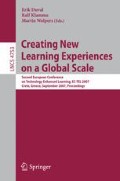Abstract
A novel approach to algorithm animation consists in displaying algorithms based on their design technique. In this paper, we describe a framework to generate these animations without effort from the instructor. We describe a preprocessing phase that modifies the source code of the algorithm to visualize. When the transformed code is executed, a trace is stored and then used to generate an animation. We also describe the architecture of the animation subsystem. Finally, we outline the main features of SRec, a system that we have built to illustrate the feasibility of this approach. It is aimed at visualizing multiple views of recursion, namely traces, the control stack and activation trees.
Access this chapter
Tax calculation will be finalised at checkout
Purchases are for personal use only
Preview
Unable to display preview. Download preview PDF.
References
Naps, T., et al.: Exploring the role of visualization and engagement in computer science education. ACM SIGCSE Bulletin 35(2), 131–152 (2003)
Naps, T., et al.: Evaluating the educational impact of visualization. ACM SIGCSE Bulletin 35(4), 124–136 (2003)
Ihantola, P., Karavirta, V., Korhonen, A., Nikander, J.: Taxonomy of effortless creation of algorithm visualization. In: Proc. 2005 International Workshop on Computing Education Research, pp. 123–133. ACM Press, New York (2005)
Velázquez-Iturbide, J.Á., Pareja-Flores, C., Urquiza-Fuentes, J.: An approach to effortless construction of program animations. Computers & Education (in press)
Urquiza-Fuentes, J., Velázquez Iturbide, J.Á.: An evaluation of the effortless approach to build algorithm animations with WinHIPE. In: Proc. Fourth Program Visualization Workshop, University of Florence, Italy, pp. 29–33 (2006)
Fernández-Muñoz, L., Velázquez-Iturbide, J.Á.: A study of visualizations for algorithm design techniques. In: Proc. VII International Conf. Human-Computer Interaction, Universidad de Castilla-La Mancha, Spain, pp. 315–324 (in Spanish) (2006)
Gamma, E., Helm, R., Johnson, R., Vlissides, J.: Design Patterns, Elements of Reusable Object-Oriented Software. Addison-Wesley, Reading (1995)
Korhonen, A., Malmi, L., Saikkonen, R.: Design pattern for algorithm animation and simulation. In: Proc. First Program Visualization Workshop, pp. 89–100. University of Joensuu, Finland (2000)
Kumar, A.N., Kasabov, S.: Observer architecture of program visualization. In: Proc. Fourth Program Visualization Workshop, pp. 17–22. University of Florence, Italy (2006)
Wilcocks, D., Sanders, I.: Animating recursion as an aid to instruction. Computers & Education 23(3), 221–226 (1994)
Dershem, H.L., Parker, D.E., Weinhold, R.: A Java function visualizer. Journal of Computing in Small Colleges 15(1), 220–230 (1999)
George, C.E.: EROSI – Visualizing recursion and discovering new errors. In: Proc. 31st SIGCSE Technical Symp. on Computer Science Education, pp. 305–309. ACM Press, New York (2000)
Terada, M.: ETV: A program trace player for students. In: Proc. 10th Annual Conference on Innovation and Technology in Computer Science Education, pp. 118–122. ACM Press, New York (2005)
Wu, C.-C., Lin, J.M.-C., Hsu, I.Y.-W.: Closed laboratories using SimLIST and SimRECUR. Computers & Education 28(1), 55–64 (1997)
Author information
Authors and Affiliations
Editor information
Rights and permissions
Copyright information
© 2007 Springer-Verlag Berlin Heidelberg
About this paper
Cite this paper
Fernández-Muñoz, L., Pérez-Carrasco, A., Velázquez-Iturbide, J.Á., Urquiza-Fuentes, J. (2007). A Framework for the Automatic Generation of Algorithm Animations Based on Design Techniques. In: Duval, E., Klamma, R., Wolpers, M. (eds) Creating New Learning Experiences on a Global Scale. EC-TEL 2007. Lecture Notes in Computer Science, vol 4753. Springer, Berlin, Heidelberg. https://doi.org/10.1007/978-3-540-75195-3_40
Download citation
DOI: https://doi.org/10.1007/978-3-540-75195-3_40
Publisher Name: Springer, Berlin, Heidelberg
Print ISBN: 978-3-540-75194-6
Online ISBN: 978-3-540-75195-3
eBook Packages: Computer ScienceComputer Science (R0)

